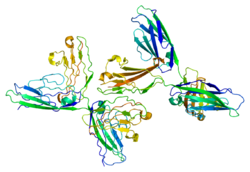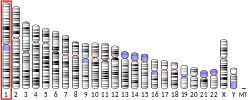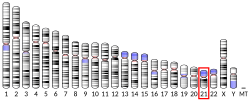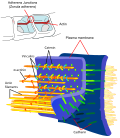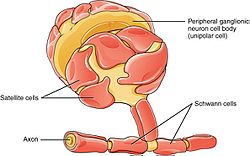functionality, adhesions and adhesion molecules have been a topic of study within the scientific community. Specifically, it has been found that adhesions are involved...
15 KB (1,859 words) - 20:29, 16 September 2021
Neural cell adhesion molecule (NCAM), also called CD56, is a homophilic binding glycoprotein expressed on the surface of neurons, glia and skeletal muscle...
12 KB (1,445 words) - 16:30, 31 December 2023
Epithelium Cytoskeleton Differential adhesion hypothesis Role of cell adhesions in neural development Alberts, Bruce; Johnson, Alexander; Lewis, Julian; Morgan...
32 KB (3,664 words) - 09:37, 11 June 2025
Brain development timelines Malleable intelligence Role of cell adhesions in neural development "Neurological Signs & Diseases". 2 November 2016. Archived...
53 KB (6,309 words) - 05:12, 9 June 2025
Cell adhesion molecules (CAMs) are a subset of cell surface proteins that are involved in the binding of cells with other cells or with the extracellular...
16 KB (1,889 words) - 11:50, 12 June 2025
create the neural tube. The figure demonstrates the development of the neural plate into the neural tube, which is where the neural crest cells are derived...
18 KB (2,461 words) - 04:22, 16 July 2024
WNT3A (section Role in embryonic development)
causes the growth of colon progenitors Wnt3a expands neural crest cells during early development Wnt3a promotes hematopoietic stem cell self-renewal. Wnt3a...
15 KB (1,657 words) - 01:54, 5 June 2025
adhesion. This means that EpCAM on the surface of one cell binds to the EpCAM on a neighboring cell thereby holding the cells together. The adhesions...
20 KB (2,451 words) - 18:22, 29 November 2024
Juxtacrine signalling (category Cell signaling)
cells and/or the extracellular matrix Role of cell adhesions in neural development Cell adhesion molecules Pannexin, vertebrate proteins used to form...
12 KB (1,361 words) - 00:25, 24 May 2025
development. Neural crest cells originate from this structure through the epithelial-mesenchymal transition, and in turn give rise to a diverse cell lineage—including...
41 KB (4,610 words) - 19:21, 1 April 2025
DSCAM (section Regulation of synaptogenesis)
on its cell surface. Dscam interaction stimulates neuronal self-avoidance mechanisms that are essential for normal neural circuit development. The DSCAM...
32 KB (3,755 words) - 10:23, 22 May 2025
associated with sporadic cases of neural tube defects. SNAI2 downregulates expression of E-cadherin in premigratory neural crest cells; thus, SNAI2 induces tightly...
13 KB (1,627 words) - 21:25, 22 May 2025
Cadherin (category Cell adhesion proteins)
anterior-posterior axis of the vertebrate. N-cadherins have different functions that maintain the cell structure, cell-cell adhesion, internal adhesions. They participate...
32 KB (3,588 words) - 09:48, 22 May 2025
Catenin beta-1 (category Wikipedia articles incorporating text from the United States National Library of Medicine)
that in humans is encoded by the CTNNB1 gene. β-Catenin is a dual function protein, involved in regulation and coordination of cell–cell adhesion and gene...
107 KB (12,347 words) - 14:08, 17 March 2025
The neural fold is a structure that arises during neurulation in the embryonic development of both birds and mammals among other organisms. This structure...
14 KB (1,551 words) - 21:27, 15 May 2024
Folliculin (category Wikipedia articles with corresponding articles published in Gene)
maintenance of cell architecture in epithelial tissues, and regulates RhoA activity. Loss of FLCN function leads to a disruptive effect on cell-cell adhesions and...
48 KB (5,618 words) - 19:50, 9 April 2025
differentiation from the neural crest. NRG1 plays important roles in the development of neural crest derivatives. It is required for neural crest cells to migrate past...
19 KB (2,448 words) - 10:54, 2 May 2025
Intercellular communication (redirect from Cell bridge)
groups of nerve cells exhibiting ephaptic coupling with particular functions in the brain. As yet there are no studies on the simplest neural systems...
37 KB (4,450 words) - 01:30, 25 May 2025
Morphogenesis (section Cell-to-cell adhesion)
sort out. In cell culture cells that have the strongest adhesion move to the center of a mixed aggregates of cells. Moreover, cell-cell adhesion is often...
25 KB (2,724 words) - 18:06, 10 August 2024
Invagination (redirect from Cell invagination)
embryonic development. Invagination is critical for making the primitive gut during gastrulation in many organisms, forming the neural tube in vertebrates...
28 KB (3,615 words) - 08:43, 9 February 2025
Neurulation (redirect from Neural tube defect, folate-sensitive)
hinge cause the neural folds to meet and fuse at the midline. The fusion requires the regulation of cell adhesion molecules. The neural plate switches...
26 KB (3,288 words) - 16:09, 25 May 2025
in expression of a heterodimeric receptor at the cell surface. Ligand profiles and in vitro studies have indicated a role for adhesion GPCRs in cell adhesion...
30 KB (3,499 words) - 22:35, 29 March 2024
Endometriosis (redirect from Endometriotic cell)
the ovary and more adhesions. Stage IV (Severe) As above, plus large endometriomas and extensive adhesions. Implants and adhesions may be found beyond...
164 KB (16,769 words) - 19:50, 18 June 2025
Extracellular matrix (redirect from Substrate adhesion molecules)
multicellular structures; however, cell adhesion, cell-to-cell communication and differentiation are common functions of the ECM. The animal extracellular...
36 KB (4,121 words) - 13:42, 26 April 2025
Mesenchyme (section Neural mesenchyme)
N-cadherin, and neural cell adhesion molecule. NCCs ingress into the embryo from the epithelial neuroectodermal layer and migrate throughout the body in order form...
17 KB (1,683 words) - 07:03, 26 April 2025
Neural crest cells are multipotent cells required for the development of cells, tissues and organ systems. A subpopulation of neural crest cells are the...
37 KB (4,546 words) - 18:45, 27 May 2025
degenerate primary repertoires of neuronal groups. The development of neural Darwinism was deeply influenced by work in the fields of immunology, embryology,...
62 KB (7,274 words) - 14:10, 25 May 2025
Cadherin-1 (category Wikipedia articles incorporating text from the United States National Library of Medicine)
understood about the specific roles these ions played. Therefore, Takeichi’s work in discovering calcium’s role in cell-cell adhesion was highly transformative...
54 KB (6,381 words) - 16:54, 2 June 2025
Epithelial–mesenchymal transition (category Diseases of liver)
epithelial cells lose their cell polarity and cell–cell adhesion, and gain migratory and invasive properties to become mesenchymal stem cells; these are...
59 KB (6,840 words) - 03:28, 4 May 2025
Nerve injury (redirect from Neural insult)
neural cells, neurite promoting factors play a role in adhesion of the axon and include neural cell adhesion molecule (N-CAM) and N-cadherin. Unless otherwise...
34 KB (4,120 words) - 18:50, 10 June 2025


